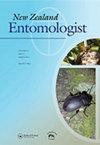番茄马铃薯木虱若虫cockerelli Bactericera (Šulc)(半翅目:Triozidae)被捕食性螨bacaccarum L.(恙螨目:恙螨科)捕食
IF 0.4
4区 农林科学
Q4 ENTOMOLOGY
引用次数: 13
摘要
摘要本研究研究了巴卡芽孢螨对番茄马铃薯木虱科克雷杆菌属若虫的捕食行为。在30分钟的实验室生物分析中,如果晚期木虱若虫被“支撑”或“密封”在叶子上,每只螨的捕食率很低,在木虱糖(蜡覆盖的蜜露)存在的情况下,12只若虫中只有一只被成功攻击和吃掉。然而,如果若虫与叶片分离并倒立,则捕食率大约高出六倍。木虱糖的存在对捕食率有影响,因为螨虫会探测或调查,并经常以这些糖为食,有时会导致螨虫立即停止对木虱的调查。总的来说,这项调查的结果证实,这些螨虫消耗晚期木虱若虫,但可能需要在木虱大量减少之前达到高密度。螨虫可能是木虱卵或幼龄虫更有效的捕食者,这种捕食行为值得进一步研究。本文章由计算机程序翻译,如有差异,请以英文原文为准。
Predation of nymphal tomato potato psyllid, Bactericera cockerelli (Šulc) (Hemiptera: Triozidae), by the predatory mite, Anystis baccarum L. (Trombidiformes: Anystidae)
ABSTRACT This study investigated predatory behaviour of the mite Anystis baccarum on nymphs of the tomato potato psyllid Bactericera cockerelli. In 30-minute laboratory bioassays, predation rates per individual mite were low if late instar psyllid nymphs were ‘braced’ or ‘sealed’ tightly to a leaf, with only one nymph from twelve being successfully attacked and eaten in the presence of psyllid sugars (wax covered honeydew). However predation rates were approximately six times higher if the nymph was detached from the leaf and inverted. The presence of psyllid sugars had an impact on predation rates because mites would probe or investigate, and often feed from these sugars, sometimes leading to the immediate cessation of the mite’s investigation of the psyllid. Overall, the results of this investigation confirm that these mites consume late instar psyllid nymphs but may need to be at high densities before substantial reductions in psyllids occurred. The mites may be a more effective predator of psyllid eggs or younger instars and this predatory behaviour warrants further investigation.
求助全文
通过发布文献求助,成功后即可免费获取论文全文。
去求助
来源期刊

New Zealand Entomologist
ENTOMOLOGY-
CiteScore
0.70
自引率
33.30%
发文量
3
审稿时长
>12 weeks
期刊介绍:
The invertebrate diversity of New Zealand is of great interest worldwide because of its geographic isolation and geological history. The New Zealand Entomologist plays an important role in disseminating information on field-based, experimental, and theoretical research.
The New Zealand Entomologist publishes original research papers, review papers and short communications. We welcome submissions in all aspects of science regarding insects and arthropods in a New Zealand or Australasian setting. The journal’s subject matter encompasses taxonomy, phylogenetics, biogeography, biological control and pest management, conservation, ecology and natural history.
The journal is the official publication of the Entomological Society of New Zealand. Papers published or submitted elsewhere for publication will not be considered, but publication of an abstract or summary elsewhere (e.g. conference proceedings) does not preclude full publication in the New Zealand Entomologist. Accepted papers become copyright of the Entomological Society of New Zealand. The journal is published in English, but we also welcome publication of abstracts in Maori.
 求助内容:
求助内容: 应助结果提醒方式:
应助结果提醒方式:


